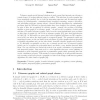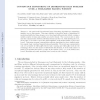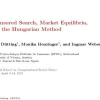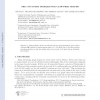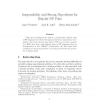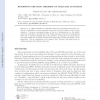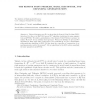STACS
2010
Springer
15 years 8 months ago
2010
Springer
Tolerance graphs model interval relations in such a way that intervals can tolerate a certain degree of overlap without being in conflict. This subclass of perfect graphs has bee...
108
Voted
STACS
2010
Springer
15 years 8 months ago
2010
Springer
The past decade has witnessed many interesting algorithms for maintaining statistics over a data stream. This paper initiates a theoretical study of algorithms for monitoring distr...
STACS
2010
Springer
15 years 8 months ago
2010
Springer
STACS
2010
Springer
15 years 8 months ago
2010
Springer
Testing whether there is an induced path in a graph spanning k given vertices is already NP-complete in general graphs when k = 3. We show how to solve this problem in polynomial t...
101
click to vote
STACS
2010
Springer
15 years 8 months ago
2010
Springer
Kabanets and Impagliazzo [KI04] show how to decide the circuit polynomial identity testing problem (CPIT) in deterministic subexponential time, assuming hardness of some explicit ...
STACS
2010
Springer
15 years 8 months ago
2010
Springer
This paper investigates the existence of inseparable disjoint pairs of NP languages and related strong hypotheses in computational complexity. Our main theorem says that, if NP do...
100
Voted
STACS
2010
Springer
15 years 8 months ago
2010
Springer
We present a method for reducing the treewidth of a graph while preserving all the minimal s−t separators. This technique turns out to be very useful in the design of parameteriz...
87
Voted
STACS
2010
Springer
15 years 8 months ago
2010
Springer
Abstract. A cellular automaton is a parallel synchronous computing model, which consists in a juxtaposition of finite automata whose state evolves according to that of their neigh...
103
Voted
STACS
2010
Springer
15 years 8 months ago
2010
Springer
We show that the Tile Assembly Model exhibits a strong notion of universality where the goal is to give a single tile assembly system that simulates the behavior of any other tile...
STACS
2010
Springer
15 years 8 months ago
2010
Springer
Using ε-bias spaces over F2, we show that the Remote Point Problem (RPP), introduced by Alon et al [APY09], has an NC2 algorithm (achieving the same parameters as [APY09]). We stu...
